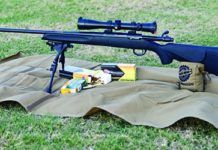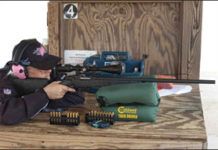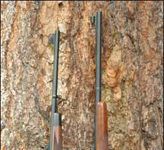The bolt action rifle is easily the most popular type of centerfire hunting rifle in this country, and for good reasons. They are accurate, reliable and easy to use. The second most popular type of hunting arm is the lever action rifle. Such guns aren’t accurate at long distances, but these easy-handling firearms are just what is needed in the brush where distances are short.
Excluding rimfire models, the least popular type of hunting firearm is the pump action rifle. This is probably because one of the main contact points between a rifle and a shooter or rest, the forend, isn’t fixed and typically has some side-to-side play. If a gun isn’t held steady, it is difficult to hit the intended target.
The advantage of a pump action rifle is that it works like a pump shotgun. So, a person who hunts birds with a pump scattergun doesn’t have to remember how to operate a different type of gun when her or she wants to hunt deer with a rifle. There are only two pump action rifles made in high power calibers. They are the Remington Model 7600 and the Browning BPR. Both are included in this head-to-head test. Versions chambered for the .270 Winchester cartridge were chosen for this evaluation.
The Test Rifles
The Browning BPR (Browning Pump Rifle) is an interesting firearm. It looks more like a semiautomatic than a pump, which isn’t surprising because it was intentionally designed to look like the manufacturer’s BAR rifle. When the action is cycling, the large forend cams downward as it is pumped rearward. Features include a seven-lug rotary bolt, a free-floating barrel and a detachable magazine on a hinged floorplate. This model is offered in four standard and two magnum calibers, from .243 Winchester to .300 Winchester Magnum.
Until the introduction of the Browning last year, the Remington Model 7600 was the only pump action rifle made in high power calibers. Its appearance and operation is somewhat like the manufacturer’s Model 870 pump shotgun. This model features a rotary bolt, a free-floating barrel and a detachable magazine. Versions in five standard calibers from .243 Winchester to .30-06 are available.
Observations
The $690 Browning BPR we acquired was a handsome .270 rifle. Its steel parts had a highly polished blue finish that nearly matched the aluminum alloy receiver’s shiny black finish. The alloy trigger guard and floorplate were matte black. The two-piece stock was made of select reddish-brown walnut with a high gloss finish. Its checkering was carefully cut. The black rubber recoil pad with black spacer was expertly installed, as was the blued steel swivel stud on the underside of the buttstock. There wasn’t a second swivel stud on the front of the rifle.
In our opinion, the Browning’s workmanship was above average. A few superficial tool marks were noted on the interior of the receiver and the underside of the bolt, but no sharp edges were found. Most moving parts had only a minor amount of play. There was a small intentional gap between the rear of the trigger guard and the buttstock to facilitate the removal of the trigger assembly. The forend had a small amount of undesirable side-to-side movement.
Our .270 Remington Model 7600, which retailed for $540, wasn’t as good looking as the Browning BPR. We felt its comparatively small forend looked too short. The steel barrel had a brushed blue finish, while the steel receiver had a polished blue finish and engraving-like decoration. There was a deer scene on the right side and a bear scene on the left. The aluminum alloy trigger guard had a shiny black finish. The two-piece stock was made of dark brown walnut with a black forend tip and pistol grip cap. Its smooth, satin finish and cut checkering were neatly done. The black plastic butt plate was well installed. There were no swivel studs to aid in the installation of a sling.
[PDFCAP(2)].We considered the Remington’s metal and wood work to be average. Numerous minor tool marks were found on the exterior of the bolt and the interior of the receiver. Some moving parts, such as the trigger, had a moderate amount of side-to-side play. There was an overly large gap between the rear of the trigger guard and the buttstock, intended to make removing the trigger assembly easier. The forend had a moderate amount of unwanted side-to-side movement.
Controls
All of the Browning BPR’s controls could be operated with the shooter’s trigger finger. The action release lever on the right side of the trigger guard unlocked the action when moved forward. The floorplate catch at the front of the trigger guard unlocked the back of the hinged floorplate when pulled rearward. The crossbolt safety at the rear of the trigger guard prevented firing by blocking the sear when pushed from left to right. Although the safety’s movement was stiff, the other controls worked smoothly.
All of the Remington Model 7600’s controls worked positively, but its action release wasn’t as conveniently located as the Browning. The action release, a lever at the left front of the trigger guard, unlocked the action when pulled up and to the rear. The magazine release lever at the right front of the trigger guard unlocked the magazine when rocked forward. The crossbolt safety at the rear of the trigger guard prevented firing by blocking the sear when pushed from left to right.
Handling
Shooters found that the 1/4-pound lighter Browning BPR was a little more muzzle-heavy than the Remington. Target acquisition was very good. Shouldering was natural, and the comfortable rubber recoil pad was very non-slip. The buttstock’s straight comb afforded a stockweld with good cheek and jaw contact. The 13 1/2-inch-long forend provided plenty of gripping area and could be grasped solidly. The pistol grip was comfortable and not overly wide. Felt recoil was average for a .270 rifle.
The Remington Model 7600’s heavier weight was offset by its relatively even balance. Target acquisition was good. Shouldering was smooth, but most of our shooters considered the stock’s 13 1/2-inch length of pull to be too short. Although the butt plate was partially checkered, it was slippery. Furthermore, the plastic butt plate didn’t cushion the rifle’s kick, so it seemed to recoil more than the Browning. The buttstock’s elevated comb afforded a stockweld with very good cheek and jaw contact. The 8 1/2-inch-long forend provided an adequate amount of gripping area and a good grasp. The pistol grip was slim, but reasonably comfortable.
Triggers
Movement of the BPR’s trigger wasn’t up to Browning’s usual high standard, but we considered it to be adequate for hunting. After 1/16 inch of takeup, the pull had a somewhat mushy 4 1/2-pound release. There was minor overtravel. The gold-colored trigger had an ungrooved 5/8-inch-wide face with comfortably rounded edges.
In our opinion, the Remington Model 7600’s trigger movement was less desirable than the BPR. Its pull had 3/32 inch of takeup and a very mushy 4 1/2-pound release. There was a moderate amount of overtravel. The blued trigger had an ungrooved 3/16-inch-wide face with uncomfortably squared edges.
Sights
Our shooters felt the Browning BPR’s open sight were excellent. The front was a hooded blade with a bead-shaped top and a gold-colored face. It sat on a 1/2-inch-high ramp. The rear had a large face with a U-shaped notch, which could be adjusted by micrometer windage and elevation screws. These very large screws made adjusting the sights a snap. This arrangement provided a well-defined sight picture.
The Remington Model 7600 was equipped with the manufacturer’s usual rifle sights, which we felt were adequate. The front, a blade with a bead-shaped top and a white face, sat on a 3/8-inch-high base. The rear, a sliding blade with a U-shaped notch, sat on an inclined base. After loosening the appropriate screw, the rear sight could be moved for windage and elevation adjustments. Adjusting the sights was tedious. This system provided a useable sight picture.
Each rifle’s receiver top was drilled and tapped for a scope mount. Using one-piece bases and Redfield-type rings (not provided), both guns were equipped with Burris Fullfield 3-9x scopes for accuracy testing.
At The Range
During the firing phase of this test, the Browning BPR’s functioning was 100 percent reliable with the three kinds of commercial ammunition we used. However, the action cycled stiffly, especially at the beginning of the forend’s forward (return) movement. Another thing we discovered was that, when the forend was to the rear (action open), it blocked the shooter’s access to the hinged floorplate and detachable magazine. So, the forend had to be in the forward position (action closed) to load or unload the magazine.
The Browning’s accuracy was more than acceptable for a .270 hunting rifle. It produced the best three-shot average groups of the test, 1.05 inches at 100 yards, with Remington 140-grain Extended Range boattails. The Winchester and Federal loads were good for 1.45 and 1.50-inch groups, respectively.
[PDFCAP(3)].No malfunctions were encountered while firing the Remington Model 7600. The action’s movement was at least twice as easy as the Browning BPR. When the forend was to the rear, it didn’t cover the removable magazine. However, the magazine couldn’t be fully inserted into the magazine well unless it was positioned just right, which slowed reloading and frustrated most of our shooters.
In our opinion, the Remington’s accuracy was below average. This .270’s smallest three-shot average groups, 1.50 inches at 100 yards, were obtained with Remington 140-grain Extended Range boattails. The Federal and Winchester loads only managed 2.05 and 2.30-inch groups, respectively.
The results of our chronograph testing are in the accompanying Performance Table. There were no significant findings.































Is the model 7600 270 for sale